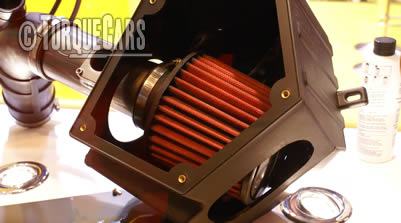An induction kit is quite simply an air filter. Most cars have air filters mounted in an air box.
These filters are generally constructed of paper which filters out the particles from the air and prevents these from getting into the engine. The airboxes are designed to reduce the noise of the engine and have various vanes and angles cut to maximise this noise reduction.
Because the air is not flowing freely through the filter there is potentially a loss of power due to the turbulence caused by all that sound deadening. To make up for this loss of power the air filter surface area is a lot larger than the intake tubes so manufactures have effectively closed the gap between, noise reduction and performance.
When it comes to car tuning noise reduction is generally the last thing on peoples mind. Swapping out the restrictive air box with an open filter helps to improve the flow of air into the engine and fully releases the induction roar, a noise associated with tuners cars the world over.
The induction kit is quite simply an open air filter shaped like a cone, dome or tube.
Engines with induction kits fitted typically see the power gains quite high up the RPM range. Low down power can be compromised. In small engines the effect of an induction kit is a noticeable loss of low end power. This is fine if you want to use the top end of the RPM range all the time, like you would in a race environment but on the street this is just not viable. Fuel usage would be much higher and you will be causing a noise nuisance to your neighbours.
Induction kits flow better than paper elements partly because they do less filtering. Induction kits are still efficient filters but they are never going to be as effective as an OEM paper filter.
Do inductions kits always add power?
NO - typically power gains are toward the top end of the RPM range and some engines will show a power loss, especially low down.
Do induction kits add fuel economy?
By sucking in warm engine bay air the engine will use less fuel, so round town you might notice a slight improvement in MPG but the induction roar promotes a heavier driving style which negates this.
Are all induction kits the same?
No, quality varies considerably. We recommend filters that are using a cotton gauze filtration medium. Some kits come with high flow air boxes and air intakes designed specifically for a car and these will usually out perform basic filter only kits.

Are induction kits hard to fit?
Induction kits are very simple to fit. You may need to cut a pipe or two but most kits can be fitted in 4 minutes with just a screwdriver.
I fitted an induction kit and I have flat spots?
Wait for a while. Modern engines may need to adjust to the new air flow characteristics. They will auto trim the fuelling based on lambda readings. If after a tank of fuel you still get flat spots then you should check your fuel delivery. Running lean can be a problem and some have noted that fitting a sports exhaust will further improve things.
What is the main benefit of an induction kit?
If you are looking for more power then there are lots of better things to spend your money on. If you want the induction roar noise then the induction kits are good value.
No comments:
Post a Comment